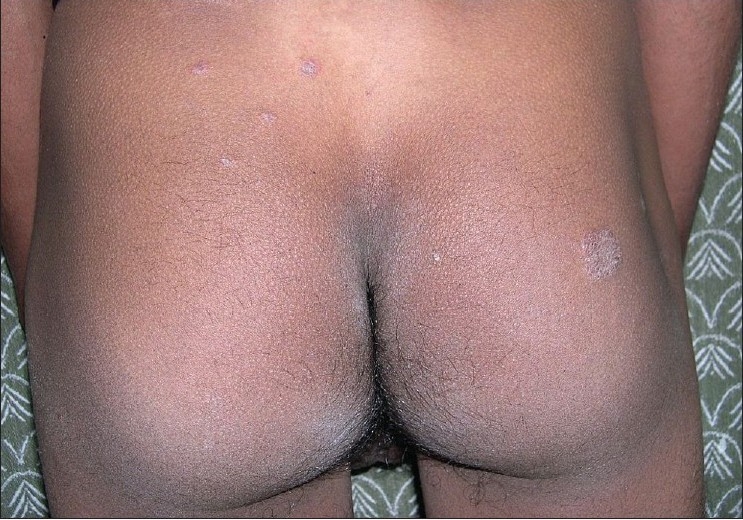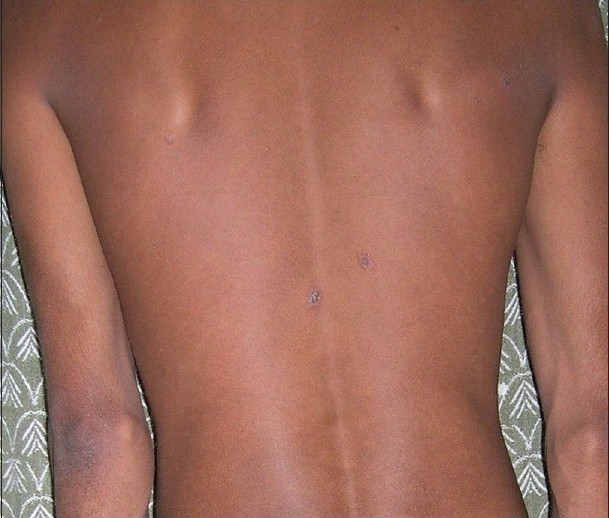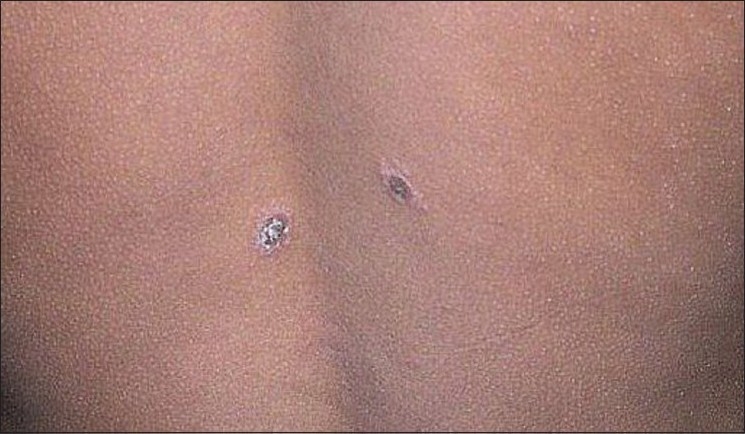Sir,
Natural history of pityriasis rosea is characterized by the onset of herald plaque, which is usually an annular eruption of 2–10 cm in size. The latter enlarges for a week or two and is followed by multiple secondary eruptions, reaching peak with numerous lesions in the next 2 weeks and the disease then slowly regresses over the next 2–6 weeks. Thus, the average duration of cutaneous illness lasts for at least 4 weeks.[1–4]
A 14-year-old boy presented with a mildly pruritic scaly plaque of about 2.5 cm size of discoid morphology on his right buttock, following a week after a transient episode of coryza. Just within a day of noting the onset of a herald plaque, he developed only a few scaly smaller plaques on lower back [Figure 1] and posterior trunk simultaneously [Figure 2]. The lesions were oriented to lines of cleavage and collarette scales were evident on some of the lesions [Figure 3]. There were no eruptions on the anterior trunk and extremities. There was no lymphadenopathy. Clinical examination of genitals, mucous membranes, palms and soles, axillae and groins was normal.
Figure 1.

Scaly discoid plaque on right buttock with few smaller eruptions on the lower back
Figure 2.

Similar smaller plaques on the posterior trunk, two on scapular areas and two on the midback, oriented to the lines of cleavage
Figure 3.

Close view of the eruptions showing typical lesions along the Langers lines with collarette scales
He received no medications before or during the illness. He was sexually inactive. There was no history of similar eruptions in past or family. He had no known drug allergy and did not apply anything on the eruptions before reporting to us. Skin scrapings from the initial and subsequent lesions were negative for fungus. Complete blood counts and blood sugar level were normal. Venereal Disease Research Laboratory (VDRL) test and HIV antibodies were negative. The skin biopsy revealed acute spongiotic dermatitis with sparse inflammatory dermal infiltrate, leading to no specific diagnosis. However, the clinical diagnosis of pityriasis rosea was convincing, considering the diagnostic criteria of pityriasis rosea.[5] The lesions completely regressed, leaving hypopigmentation, only with vaseline application twice daily within 6 days. There was no recurrence.
Discoid herald plaque rather than the annular one, its rapid transition into the secondary lesions and abortive nature of the disease are unusual features in this case. The duration of entire cutaneous manifestation in this patient was for less than 2 weeks. It is extremely unusual for herald plaque to progress to secondary eruptions within hours.[2] In a recent epidemiological study from India, only about 20% patients had resolution of all secondary eruptions within as short as 16–30 days.[6]
Amer et al.[7] pointed in their study of Black American children that the natural history of pityriasis rosea is different from that mentioned in the textbooks and majority of the children in their study had the secondary eruptions lasting for 2 weeks or slightly more.
The pathogenesis of such abortive nature of lesions is far from clear in our healthy patient. Considering a plausible hypothesis of viral origin in pityriasis rosea,[4] it remains only speculative that this patient had subclinical viral infection and subsequent milder episode due to improved acquired immune response against the same virus, thus containing the disease with restrictive involvement. But, the pathogenesis of pityriasis rosea may be much more complex.[4] Thus, we present a case of abortive pityriasis rosea for its striking and unusual manifestation.
References
- 1.Bjornberg A, Hallgren L. Pityriasis rosea, a statistical, clinical and laboratory investigation of 826 patients and matched healthy controls. Acta Derm Venereol (Stockh) 1962;42:1–68. doi: 10.2340/0001555542168. [DOI] [PubMed] [Google Scholar]
- 2.Gonzalez L, Allen R, Janniger C, Schwartz R. Pityriasis rosea: An important papulo-squamous disorder. Int J D. 2005;44:757–64. doi: 10.1111/j.1365-4632.2005.02635.x. [DOI] [PubMed] [Google Scholar]
- 3.Chuh A, Lee A, Zawar V, Sciallis G, Kempf W. Pityriasis rosea-an update. Indian J Dermatol Venereol Leprol. 2005;71:311–5. doi: 10.4103/0378-6323.16779. [DOI] [PubMed] [Google Scholar]
- 4.Drago F, Broccolo F, Rebora A. Pityriasis rosea: An update with a critical appraisal of its possible herpesviral etiology. J Am Acad Dermatol. 2009;61:303–18. doi: 10.1016/j.jaad.2008.07.045. [DOI] [PubMed] [Google Scholar]
- 5.Chuh AA. Diagnostic criteria for pityriasis rosea-a prospective case control study for assessment of validity. J Eur Acad Dermatol. 2003;17:101–3. doi: 10.1046/j.1468-3083.2003.00519_4.x. [DOI] [PubMed] [Google Scholar]
- 6.Sharma L, Shrivastava K. Clinico-epidemiological study of pityriasis rosea. Ind J Dermatol Venereol Leprol. 2008;74:647–9. doi: 10.4103/0378-6323.45113. [DOI] [PubMed] [Google Scholar]
- 7.Amer A, Fischer H, Li X. The natural history of pityriasis rosea in black American children: How correct is the “classic” description? Arch Pediatr Adolesc Med. 2007;161:503–6. doi: 10.1001/archpedi.161.5.503. [DOI] [PubMed] [Google Scholar]


